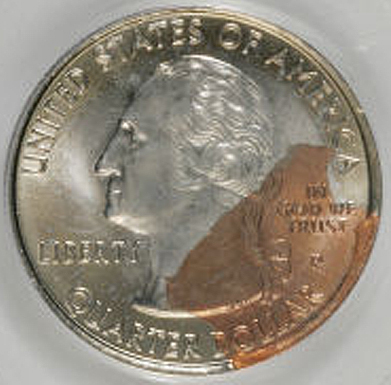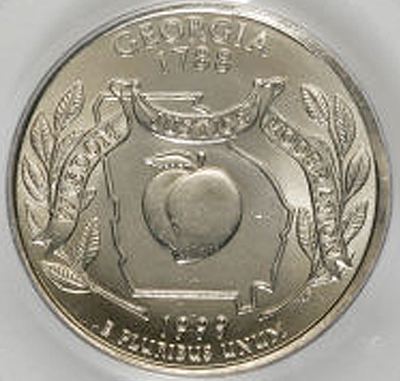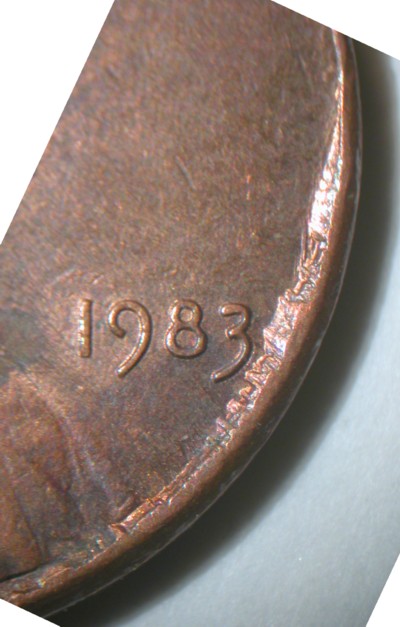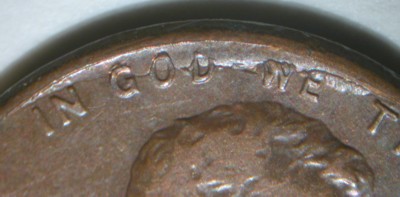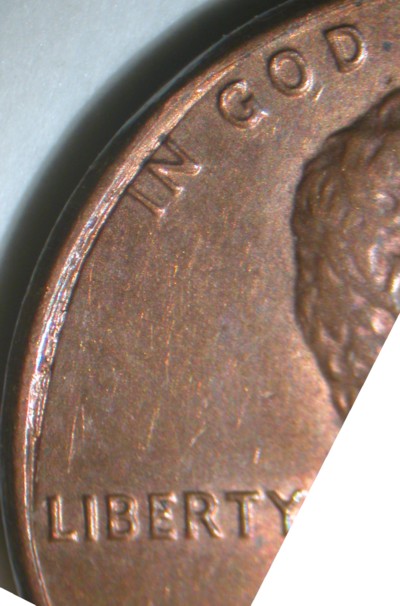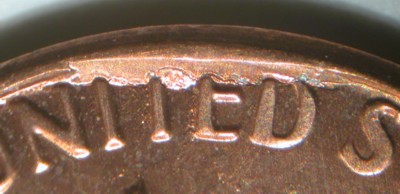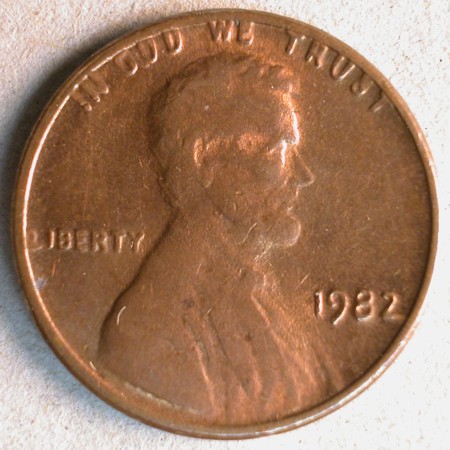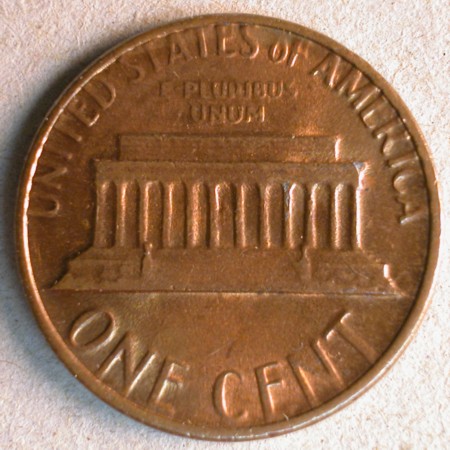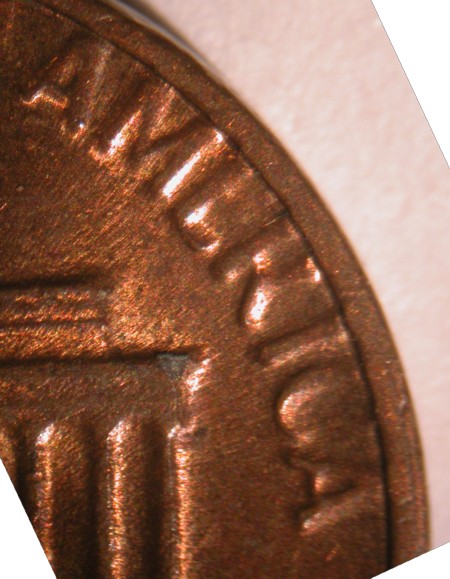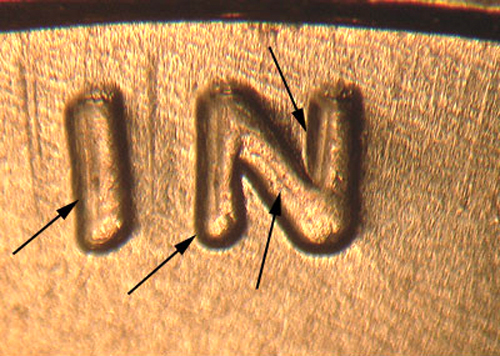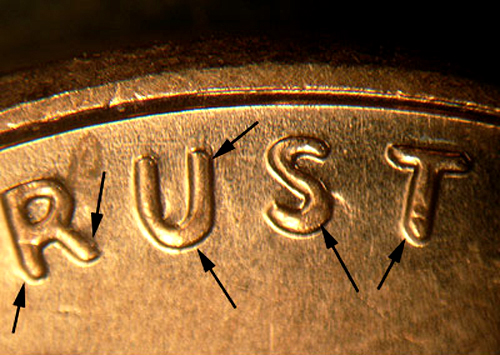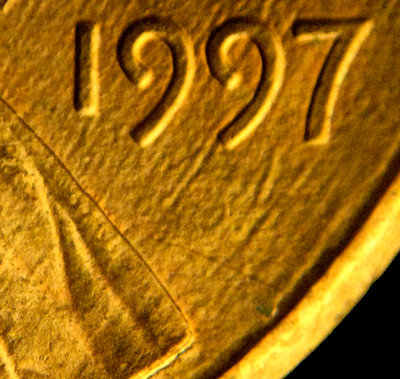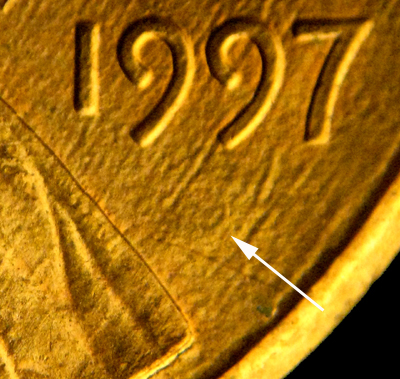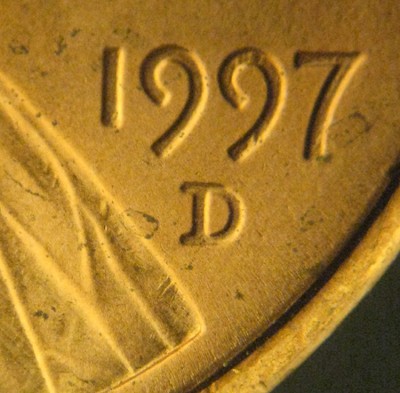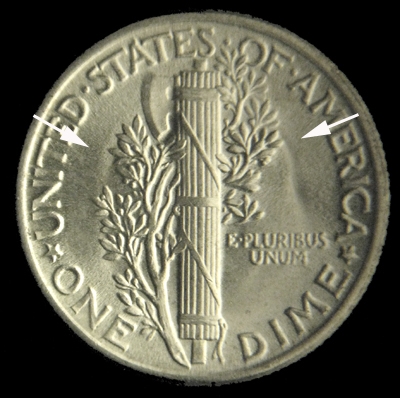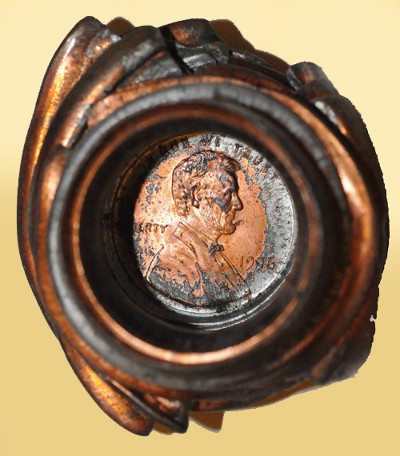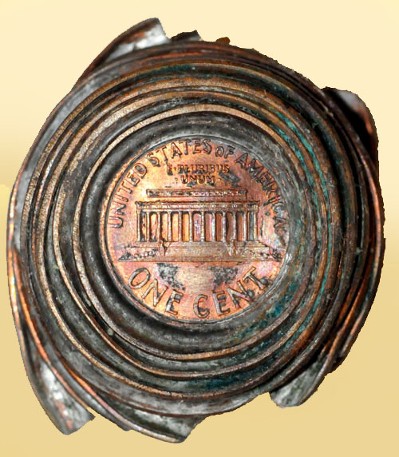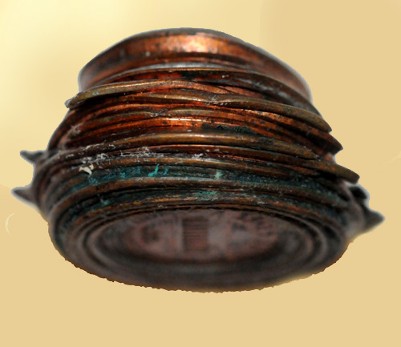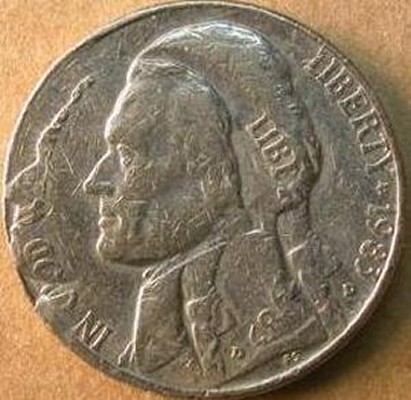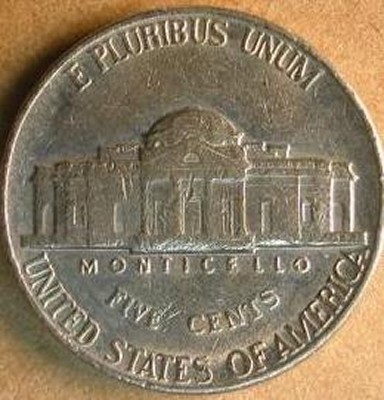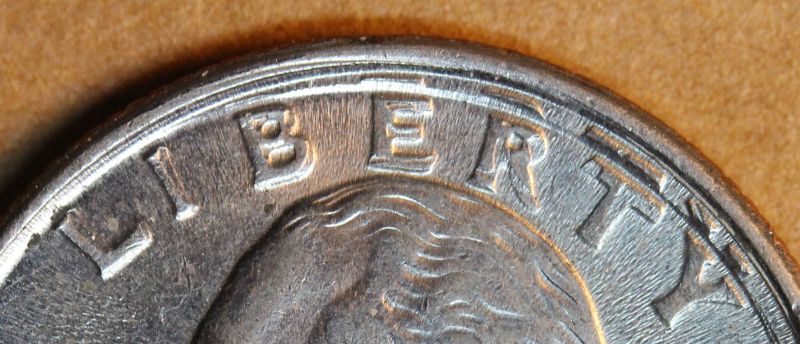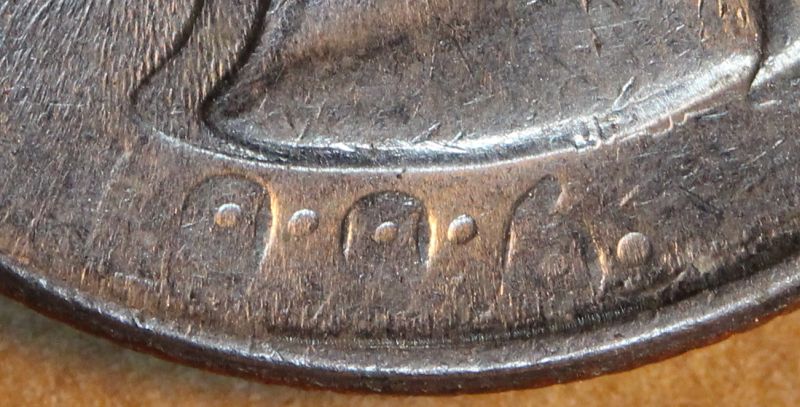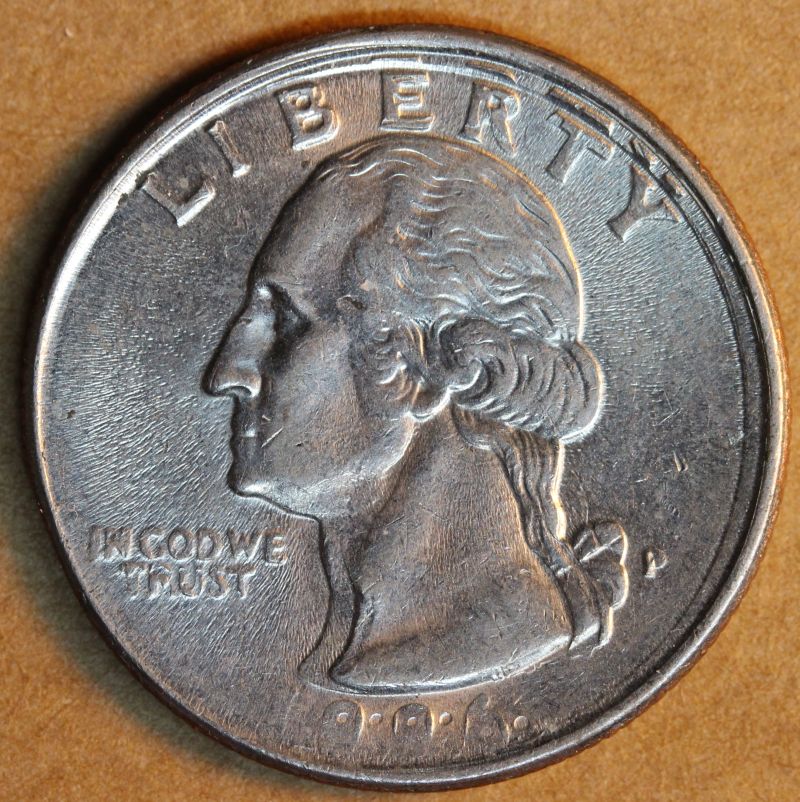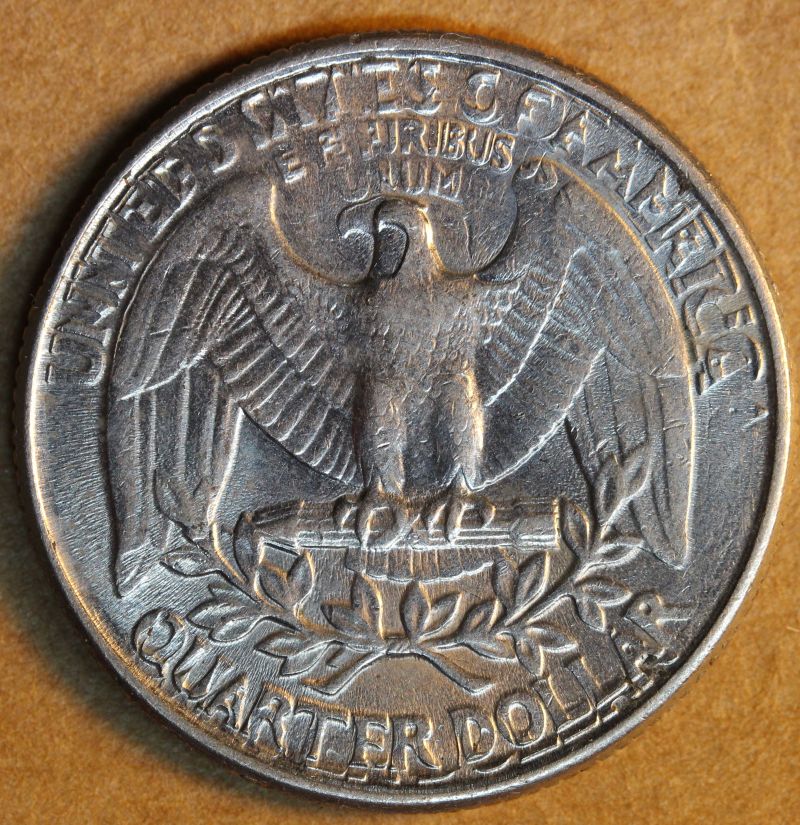Alloy errors
-
- Improper alloy mix (CW 12/27/11, 1/30/23, 4/3/23)
- Poorly mixed alloy
- Incorrect proportions of metals
- In conjunction with rolled-thick errors (1941 cents, mainly) (CW 10/15/12)
- Gas Bubbles (CW 11/19/12)
- Intact (“occluded”)
- Ruptured
- Slag inclusions (ES May/June 2006)
- Intrinsic metallic inclusions (ES Sept/Oct 2006; CW 12/27/10, 12/27/11, 7/21/14)
- Lamination errors
- Loss before strike
- Loss after strike
- Lamination cracks
- Retained laminations
- Folded-over before strike (CW 10/22/12)
- Internally split clad layer (CW 10/22/12, 6/26/17)
- Split planchets
- Before strike (CW 8/2/10)
- After strike
- Wrong Denomination / Off-metal
- Struck with another planchet on top or beneath
- Split core (clad coins)
- Clamshell split (CW 1/28/13)
- Clamshell folded over before strike (CW 10/22/12, 1/23/13)
- Hemi-split planchets (CW 10/9/23)
- Copper-and-zinc composite “shells” (ES May/June 2001)
- Split-after-strike (N.B. these are probably all detached cap bottoms)
- Cracked planchets
- Broken planchets / coins (CW 3/14/11, 9/18/23)
- Before strike
- After strike
- Brittle coins (cross-classified with annealing errors)
- Radial planchet splits (when struck out-of-collar)
- Delayed radial stress splits (CW 5/2/22)
- Planchet cohesion errors (crumbling planchets) (CW 11/22/21)
- Ragged clips (CW 2/29/16)
- Ragged notch
- Ragged perforations (“blowholes”)
- Fissures — ragged and smooth
- Stress-induced surface irregularities (CW 4/24/17)
- Rolling-Induced Fissures
- Improper alloy mix (CW 12/27/11, 1/30/23, 4/3/23)
Subsurface Corrosion (CW 12/21/15)
-
- Plated coins
- Copper-plated zinc cents
- Solid coins
- Plated coins
Rolling Mill Errors
-
- Rolled-thick planchets
- Rolled-thin planchets (CW 8/2/10, 7/16/18)
- Tapered planchets (CW 12/20/10, 12/28/15)
- On clad coins (clad layer absent) (CW 4/27/15)
- Rolling indentations (ES Jan/Feb 2000; CW 2/7/11)
- Rolled-in scrap (ES May/June 2006; CW 2/7/11)
- Bristles from descaling brush (CW 3/10/03)
- Roller marks (CW 10/13/14)
- Rolled-in patterns and textures
- Rolled-in cloth pattern (CW 3/21/16)
Blanking and Cutting Errors
-
- Definition
- Curved (concave) clips (CW 6/29/15)
- Crescent curved clips
- Bowtie clips (ES Nov/Dec 2005; CW 6/16/14)
- Two large clips at opposite poles – ends rounded
- Four clips — punch slices through strip with normal hole spacing
- Struck chopped webbing
- Straight clips (CW 1/14/13)
- Smooth straight clips
- Irregular straight clips
- Sawtooth clips
- Incomplete straight clips (actually struck-in cutting burrs)
- Straight cutting burrs (CW 1/14/13, 5/16/16)
- Corner clips (“outside corner clip”) (CW 1/14/13)
- Assay clips (“inside corner clip”) (cross-classified with pre-strike damage) (CW 1/21/13, 6/12/17)
- Ragged clips (also listed under alloy errors)
- Incomplete punch (incomplete clip) (ES May/June 2005; CW 3/24/14)
- Elliptical (convex) clips (ES May/June 2005; CW 4/5/10, 7/11/11)
- Multiple clips and combination clips (CW 1/27/14)
- Blanking burrs (“rolling fold”) (ES Jan/Feb 2007; CW 1/31/11, 5/29/17, 9/4/23)
- COIN WORLD SPECIAL: article posted HERE
- Concave blanking burrs (CW 5/16/16)
- Punched-in scrap (ES May/June 2006)
Upset Mill Errors
-
- Coins struck on blank (“Type I planchet”)
- Abnormally weak upset (ES July/August 2005)
- Abnormally strong upset (best seen on off-center strikes)
- “Groovy edge” (possibly from worn groove in upset mill)
- Variation in cross-sectional shape of rim/edge junction of planchet
- Struck coin sent back through upset mill
- Abnormal upset (ES Sept/Oct 2005; CW 2/27/12, 11/21/16)
- Wide, flat edge
- Smoothly convex edge
- Abnormally wide proto-rim
- Squeezed-in debris (upset mill inclusion) (ES May/June 2006; CW 9/6/10)
- Foil-like metal wraps around edge onto one or both faces
- e.g. Copper foil on nickels (not from improper annealing)
- Metal wire wraps around edge onto one or both faces
- Pellet embedded in edge (CW 9/6/10, 9/22/14)
- Foil-like metal wraps around edge onto one or both faces
Edge design errors (impressed into planchet before strike) (includes security edge errors) (CW 6/27/16)
-
- Edge design missing
- Edge design present on normally plain edge (CW 6/27/16)
- Wrong edge design
- Edge design too high or too low
- Interrupted edge design
- Tilted edge design
- Broken edging die (CW 6/27/16)
Mispunched center holes (foreign only) (CW 1/7/19)
-
- Misaligned holes
- Double punched center holes
- One hole centered
- Both holes misaligned
- Overlapping holes
- Totally separate holes
- Irregular center holes
- Abnormally small hole
- Partial hole (from broken hole punch)
- Circular Indentation (partial penetration)
- Due to broken-off punch tip
- Unpunched center hole
- Hole punched in planchet meant for a solid coin
Annealing Errors
-
- Improper annealing (due to excessive heat, prolonged exposure to intense heat, or excessive oxygen in annealing oven) (replaces “sintered plating” and “copper wash”) (ES July/Aug 2010; CW 11/30/09, 2/8/10)
- Black, brown, red, coppery discoloration (includes “black beauty” nickels)
- Layer of copper, often peeling
- Improper annealing (due to excessive heat, prolonged exposure to intense heat, or excessive oxygen in annealing oven) (replaces “sintered plating” and “copper wash”) (ES July/Aug 2010; CW 11/30/09, 2/8/10)
Poorly annealed or unannealed planchets (hard, brittle planchets) (CW 3/14/11)
-
- Broken planchets and coins (CW 3/14/11, 9/18/23)
- Radial cracks in coin (usually struck out-of-collar)
Brittle coins (cross-classified with alloy errors) (CW 3/14/11)
Abnormally hard planchets (CW 12/17/12, 8/15/22)
-
- 1954-S nickels
- 1983-P nickels
- COIN WORLD SPECIAL: article posted HERE
- “Superclash” 2000-P nickel (CW 3/22/10)
On undersized or underweight planchets (CW 2/13/12)
Miscellaneous forms of mint discoloration
Plating Errors
-
- Incomplete plating
- Unplated cents (CW 10/26/15, 7/24/23)
- Cents struck on unplated or partly-plated foreign planchets (CW 3/10/14)
- Thin plating
- Thick plating (ES March/April 2009)
- Blistered plating
- Circular blisters
- Linear blisters
- Intact blisters
- Ruptured blisters
- Brassy plating
- Split Plating (CW 12/18/17)
- Cracked and Peeling Plating (CW 12/18/17)
Bonding/Bonding Mill Errors (ES, Sept/Oct 2002)
-
- Missing clad layer
- Full
- Before strike (CW 5/23/22)
- After strike
- Before rolling is completed (weight may be close to normal) (ES Sept/Oct 2002, Nov/Dec 2006; CW 5/28/12)
- Partial
- Before strike
- After strike
- Before rolling is completed
- Thin cladding
- With gaps
- Missing both clad layers (struck core)
- Core thickness (ES Sept/Oct 2003; CW 3/18/13, 2/3/20)
- Full thickness
- Full
- Struck Clad layer
- Separated after strike
- COIN WORLD SPECIAL: article posted HERE
- Separated before strike
- Struck by itself
- Struck on top of or beneath a normal planchet
- Separated after strike
- Clamshell separation (CW 1/28/13)
- Clad layer folded over before strike
- Missing core
- Partial
- Full (Coreless or all-clad coins) (CW 12/19/11)
- Missing clad layer
Irregular planchets
-
- Scraps/fragments (CW 12/21/09, 1/27/20)
- Normal alloy/composition
- Off-metal
- Feeder finger material
- Foil
- Heavier than normal coin of same denomination
- Wider than normal coin of same denomination (along at least one axis)
- Ragged clip (cross-classified with alloy errors)
- Ragged notch (cross-classified with alloy errors)
- “Blowholes” (cross-classified with alloy errors)
- Fissures (cross-classified with alloy errors)
- Cracked planchets (cross-classified with alloy errors)
- Scraps/fragments (CW 12/21/09, 1/27/20)
Pristine Planchets (i.e. lacking tumbling marks) (CW 1/11/16)
Pre-Strike Damage (CW 11/15/10, 11/15/10, 1/23/12, 1/30/12, 12/15/14, 4/13/15, 6/8/20)
-
- COIN WORLD SPECIALS: articles posted HERE and HERE
- Assay clips (cross-classified with blanking errors)
- Rim burrs (CW 1/31/11)
- Accidentally and intentionally “re-sized” planchets (CW 9/15/10)
- “Crimp marks” (mostly found on off-metal errors, e.g., 5c/1c, 5c/10c)
- Rockwell test mark in planchet (circular or oval dimple) (ES July/Aug 2006; CW 10/15/18)
- Planchet with adjustment marks (gold and silver planchets filed to return heavy planchets to normal weight)
- Edge rolled, squeezed, and folded-over (or with thin apron produced) (CW 11/15/10, 1/23/12, 6/15/20)
- Pre-plating damage (zinc cents) (CW 1/23/12)
- Post-plating damage (zinc cents) (CW 11/15/10)
- Scraped-in debris (CW 2/23/15)
- Repetitive pre-strike damage (CW 12/15/14)
- Other forms of pre-strike damage
- Gouged (CW 1/14/19)
- Crushed (CW 4/13/15)
- Scraped (CW 2/23/15)
- Torn
- Crumpled (CW 8/15/11)
- Gouged (CW 1/14/19)
Inter-strike Damage (CW 1/9/12, 8/20/12)
-
- Cancelled or defaced between strikes (CW 3/25/13)
Trans-strike damage (CW 7/12/21)
Wrong planchet and off-metal errors
-
- Wrong planchet, correct composition
- Off-metal
- Domestic planchet (CW 6/22/20)
- Monroe dollar coin struck on a clad dime planchet
- 1987-P Jefferson nickel struck on clad stock
- Domestic struck on foreign planchet
- 1941-P Lincoln cent struck on a Panama 1¼ bronze centesimos
- 1920-P Lincoln cent struck on a Argentina 10 centavos planchet
- 1905-P Barber dime struck on a Panama or Philippines five centavos planchet
- 2000-P Sacagawea struck on a Ghana 100 Cedis ring
- Foreign planchet
- Unidentified origin and purpose (orphan) (ES Sept/Oct 2006, Nov/Dec 2006, March/April 2011, May/June 2011; CW 5/10/10, 12/19/11, 1/30/17, 11/30/20, 4/4/22)
- Defective and damaged off-metal planchets (CW 3/21/16)
- Foreign denomination struck on U.S. planchet
- 1970 Philippines 25 Sentimos on a U. S. cent planchet (3.1 g)
- 1972 Philippines 1 Peso on a U.S. clad 50 cent planchet
- 2000 Canadian Pride 25 cent coin struck on a United States nickel planchet
- Pure copper quarters and dimes (covered under bonding mill errors)
- Pure clad dime (covered under bonding mill errors)
- Domestic planchet (CW 6/22/20)
- Wrong stock errors
- Correct composition
- Off-metal (e.g, 1987-P nickel struck on clad quarter stock) (CW 4/22/13, 9/23/13, 9/10/18)
- Transitional stock planchets (CW 9/23/13)
- Business strike on special off-metal planchet (CW 2/10/20)
- (e.g., 40% silver-clad 1974-D and 1977-D Eisenhower dollars)
- Special strike on business planchet (CW 2/10/20)
- (e.g., 1973-S Eisenhower dollar on Cu-Ni clad planchet)
- Business strikes on proof planchets (CW 11/14/11)
- Proof strike on business planchet
- COIN WORLD SPECIAL: article posted HERE
- Wrong date error (covered under mules and die manufacturing errors)
- Double denomination errors (CW 10/3/22)
- Same year
- Different year
- Over pre-existing wrong planchet/off-metal error (ES Sept/Oct 2017; CW 2/10/2014)
- Dual country (CW 3/21/11)
- Same year
- Different year
- Intentional overstrikes (not an error)
- Transitional planchet errors (“wrong series”) (ES Sept/Oct 2001; CW 3/28/16, 8/22/16)
- Composition/year mismatch with non-overlapping production schedule
- 1943 bronze cents (CW 4/11/16)
- Composition/year mismatch with overlapping production schedule
- 1965 silver dimes and quarters
- 1964 clad dimes and quarters
- Intra-year design/composition mismatch
- 1991 Russia 10 kopek (ES Sept/Oct 2001)
- Forward-jumping transitional planchet errors (CW 3/20/17)
- Transitional/wrong denomination error
- (e.g. 1965 quarter struck on silver dime planchet)
- “Long pause” transitional planchet errors (CW 4/5/21)
- Composition/year mismatch with non-overlapping production schedule
- Struck on smaller planchet or coin
- Struck on same size planchet or coin
- Struck on re-sized planchet (dime design struck on cut-down cent planchet)
- Struck on larger planchet or coin (CW 8/22/22)
- 1981 cent on nickel planchet, uniface reverse
- 1981 dime on cent cap
- 1981 cent design struck on Susan B. Anthony dollar (several known)
- 2006 Chilean 10 pesos struck on a 100 pesos bi-metallic planchet
- Canadian “assisted errors” 1977 – 1981
- Malaysian “assisted errors” 2005-2007
- Struck on loose clad layer (covered under bonding mill errors)
- Weld seam planchets (controversial) (CW 9/24/12)
- Coins struck on washers, gears, and other hardware
- Coins struck on “aluminum” feeder fingers
- Experimental issues (CW 11/23/15, 5/23/16)
- Experimental wartime planchets (CW 12/7/09, 12/21/09)
- 1999 and 2000 state quarters on experimental planchets – tests for Sacagawea dollar (CW 11/26/01)
- 1999 Susan B. Anthony dollars struck on experimental planchets (CW 8/5/02)
- 1974 aluminum and bronze-clad steel cents (CW 1/13/03)
Bi-metallic errors (foreign only) (ES Nov/Dec 2005)
-
- Misaligned core (ES May/June 2007; CW 3/6/23)
- Misaligned center hole (ES Sept/Oct 2007)
- Well-seated core (CW 3/6/23)
- With misaligned core (CW 3/6/23)
- Double-punched center hole
- Unpunched center hole
- Solid disc of ring metal (CW 3/26/18)
- Solid disc of ring metal with embedded core
- Solid disc of ring metal with core indent
- Ring with incomplete punch (ES Sep/Oct 2007)
- Core with incomplete punch
- Struck outer ring (ES Jan/Feb 2007)
- Struck core (ES Nov/Dec 2006)
- From another denomination
- From another country (ES Sep/Oct 2009, Nov/Dec 2011)
- Struck by solid-denomination dies
- Wrong core inserted (ES Sep/Oct 2013; CW 10/17/22)
- Core-sized scrap disc of ring material inserted into disc
- Wrong ring (ES March/April 2007; CW 10/10/22)
- Ring accidentally punched from solid planchet
- Ring accidentally punched from solid coin (ES Nov/Dec 2008)
- Struck ring from another country (restruck)
- Struck core from another country (restruck)
- Unstruck core inserted into struck ring and then restruck
- Abnormally small core (controversial)
- Abnormally wide center hole (controversial)
- Abnormally thin core
- Abnormally thick core
- Abnormally thin ring
- Abnormally thick ring
- Incomplete trilaminar core
- Missing one layer (ES Mar/Apr 2010)
- Missing two layers
- Core punched out of ring strip
- Ring punched out of core strip
- Bi-metallic planchet struck by solid-denomination dies
- Solid-denomination planchet struck by bi-metallic dies (ES Mar/Apr 2014)
- Bi-metallic planchet struck by wrong bi-metallic design
